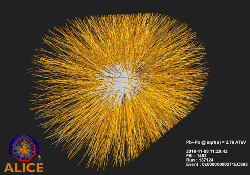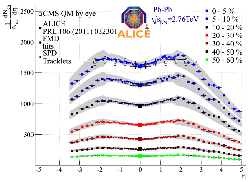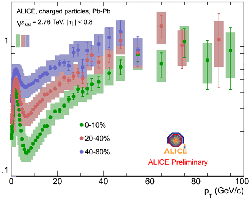New results about the primordial universe from CERN experiments

(�鶹��ԺOrg.com) -- The three LHC-experiments (ALICE, ATLAS and CMS), which study lead-collisions have their latest results at the international Quark Matter 2011 conference, held in Annecy in France with over 750 participants from all over the world. The results are based on the analysis of new data from November-December 2010, when the LHC collided lead ions at approximately 14 times higher energy than was previously possible.
The experiments have provided an abundance of measurements that bring heavy-ion physics (the study of collisions between lead nuclei and the study of super dense matter that interacts through the strong force) into a new era of precision studies. The first few days of the conference have already demonstrated that the study of Quark-Gluon-Plasma has stepped into an entirely new and quantitative phase.
Primordial universe in the spotlight
In the infancy of the universe, only a few nanoseconds after the Big Bang, the universe was comprised of plasma made up of quarks and gluons, which are the fundamental building blocks of matter. By colliding heavy ions physicists can turn back time and recreate the conditions which existed then and allow us to understand the evolution of the early universe.
The research programme of the particle accelerator Large Hadron Collider, LHC is based on ideas that were first formulated about 20 years ago and can just now be tested with unprecedented precision. In 2003, experiments in the Relativistic Heavy-Ion Collider (RHIC) at the American Brookhaven National Laboratory, with leading participation by Danish researchers from the Niels Bohr Institute, showed that quark-gluon plasma could be created on a mini-scale.

Now the ball is in CERN’s court again with full strength, and here the ALICE, CMS and ATLAS researchers have presented extensive studies of the collisions of heavy ions confirming the picture, but the picture has already become considerably nuanced only a few months after the first experimental round.
The Danish ALICE group from the Discovery Center at the Niels Bohr Institute were the first at the conference to show data demonstrating that over 25,000 new particles are formed in each collision and with that, the highest energy densities that have ever been produced under earthly conditions – in close imitation of the state of universe just ca. 10-7 after the Big Bang.
Dense as a neutron star but much, much hotter
The results from the ALICE experiment have provided evidence that the matter formed in the lead ion collisions is the densest ever observed. It is denser than a neutron star and over 100,000 times hotter than the interior of the Sun.
"These conditions make it possible to study the properties of the primordial soup in unprecedented detail. ALICE has confirmed the results of the RHIC experiments, which show that a quark-gluon-plasma behaves like a viscous liquid”, explains professor Jens Jørgen Gaardhøje, leader of the ALICE group at the Discovery Center at the Niels Bohr Institute.
The results presented are impressive – not only in comparison to various studies already available, but also in the degree of agreement between the experiments and the degree of detail in the analysis. ”It’s really moving and will shape the research front for many years to come”, says Jens Jørgen Gaardhøje.
Viscous universe
How ’sticky’ was the early universe and how do quarks move through matter? These are some of the central themes being discussed at the conference. Brand new measurements allow for the measurement of the viscosity of quark-gluon-plasma, that is to say, how fluid the early universe was. The measurements suggest that the universe was close to an ‘ideal’ liquid and now numbers could be put on how dense. The values can be compared with predictions of string theory, which predict that ‘inertia’ (the viscosity) is the lowest possible attainable.

Another one of the ’hottest’ results is that the movement of quarks through quark-gluon-plasma is perhaps different than previously thought. Jets of particles that originate from scattered quarks do not seem to spread very much, even though they are being violently crushed. It is not yet clear what the explanation is – perhaps it will lead to a brand new transport theory for quarks, i.e. particles that are ‘coloured’ and interact strongly and which we believe are the fundamental building blocks of nature.
Provided by Niels Bohr Institute





















